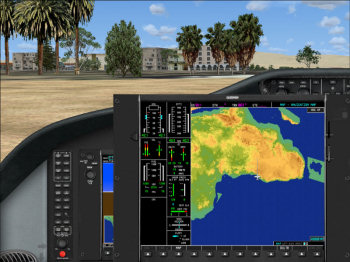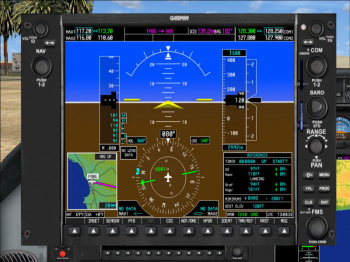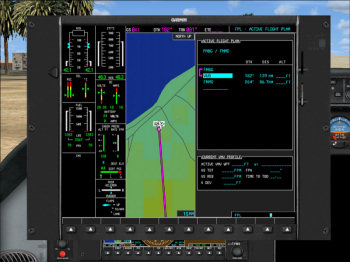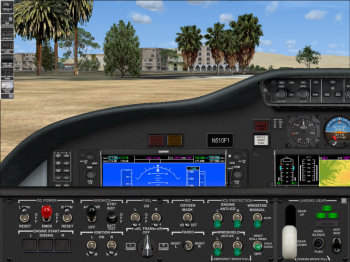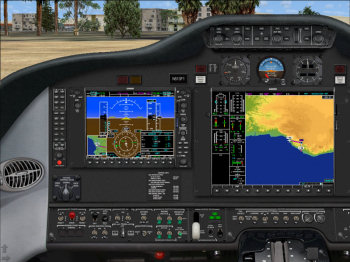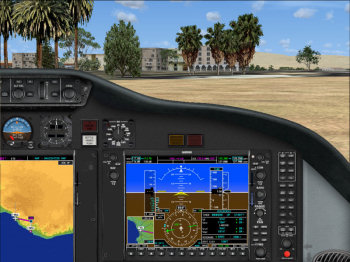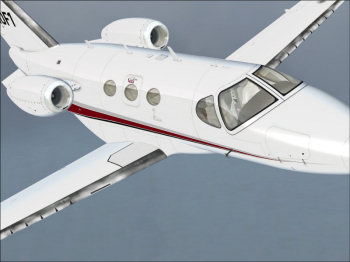Cessna Citation 510 VLJ (FSX)
Cockpit Availability and Features
(Continued)
The multi-function display and primary flight displays exhibit excellent
clarity. However, the MFD and PFD refresh rates are not
configurable by the user, having said that, the refresh rates were perfectly
acceptable on my system, offering adequate smoothness
without severely impacting performance. I did however find some of the
pop-up panels to be a little lacking in clarity, in
particular the MFD controller panel view and the left and right lower
panels. It should be considered that I am using a CRT monitor
at a low resolution, therefore I’m sure other users with LCD monitors and a
higher resolution would disagree.
I have to admit, I’m not a fan of virtual cockpits, I much prefer the 2D view for my virtual flying, however I think most users will be pleased with the virtual cockpit in the Mustang. As can be seen from the accompanying screen shots the VC is certainly on a par with other developer’s offerings, perhaps not the best rendition of a virtual cockpit but certainly not the worst.
|
Icing Effects
A very nice touch, icing effects are visible on aircraft and windscreen.
|
Flying the Mustang
So what’s the Flight1 Mustang like in the air, how well has the developer
managed to model the systems and flight dynamics?
Like most modern aircraft the biggest job during the aircrafts preflight is
programming the flight management system, in the case of the Mustang that
necessitates entering the necessary data into the Garmin G1000 all-glass
avionics suite, a unit that seems to be installed these days in everything from
the latest variant of the Cessna Skylane to the companies first VLJ the Mustang.
The G1000 is a seamlessly integrated avionics package that brings a new level of
situation awareness and safety to the cockpit and makes the task of piloting a
light jet far easier than in times gone by.
There’s a wealth of flight-critical data at your finger tips with the G1000, and
Flight1 have managed to include many of the unit’s features in their product.
Yes, there are one or two functions missing, and that will irritate a minority
of very discerning flight simulation fans but personally I didn’t find the
omissions particularly bothersome. Flight1 customers requested SID’s and STAR’s
to be added to the G1000’s capabilities, and the developer has to be commended
for providing their customers with precisely that, and in addition, ‘Navigraph’
updates to the navigation database. ‘Safe taxi’, is an obvious omission, but the
developer can hardly be blamed for it’s exclusion, equipping the Flight1
rendition of the G1000 with a full data base of world wide airport plates would
obviously be prohibitive in terms of cost.
Programming the G1000 is relatively straightforward, a task accomplished from
the pop-up flight management system alphanumeric
keypad, and once completed the flight path becomes visible on the MFD and also
on the inset map on both the pilots and co-pilots
PFD.
I must confess, when I first flew the Mustang, I instinctively pre selected
vertical autopilot modes, the flight was successful, but
this is not the primary method in the Mustang. Autopilot modes are not normally
preselected, apart from the altitude dialled in and
heading select if desired. Upon autopilot engagement, the systems basic modes
are automatically engaged, namely the wing leveller
function and pitch hold.
| MORE |
|
| BACK |
|
